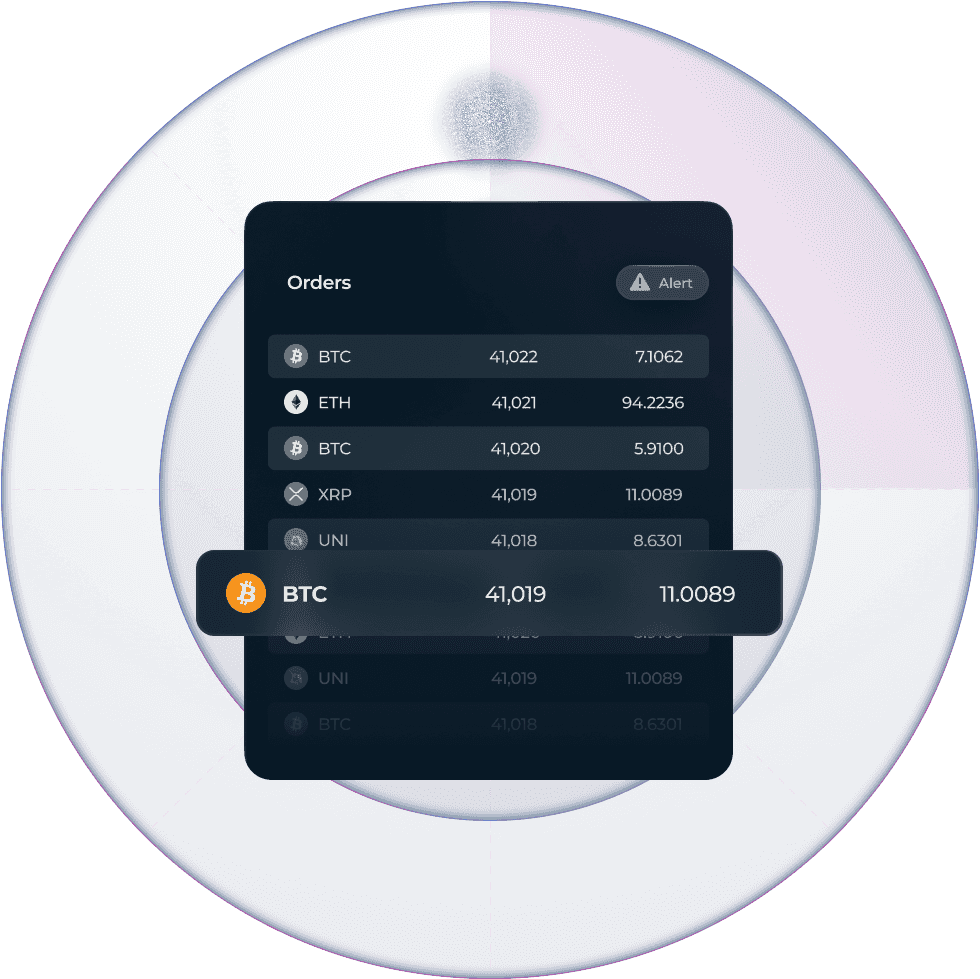Research & Blogs
CoinRoutes Q1 24 Bitcoin Liquidity Analysis

CoinRoutes
April 22, 2024
Crypto markets performed extremely well in Q1 of 2024, in large measure due to the approval and successful debut of multiple spot Bitcoin Exchange Traded Funds (ETFs). In recognition of this seminal event, this note will focus on Bitcoin products, which saw significant volume growth and volatility during the quarter. At the same time, however, the cost to source liquidity declined. Compared to the previous year, the decrease in the prevalence of crossed markets was notable and the trend of lower and less volatile trading costs indicates the continued maturation of crypto markets. The ETFs attracted over $12 billion in incremental investment in the quarter and helped Bitcoin rally over 50%. It is important to note, despite these products driving demand for US Dollar based Bitcoin, we continue to observe lower costs for trading in USDT (Tether) pairs than US Dollar pairs, and even lower costs to buy or sell Bitcoin exposure in offshore perpetual swaps markets.
Bitcoin vs US Dollar Microstructure
The market microstructure for trading Bitcoin vs the US Dollar on major exchanges was vastly different in 2024 versus 2023. Part of that is due to the market adapting to the the effects of Operation Chokepoint 2.0 we chronicled last year, but part is due to an overall increase in institutional participation, sparked by the Spot ETFs. To illustrate the comparison, we will use the CoinRoutes RealPrice™ data, which calculates the cost to buy & sell $25,000, $100,000, $250,000, $500,000 and $1M using optimal routing across all the major crypto exchanges.
In 2023, one can see that there were marked disparities, quite often, between the prices on the major exchanges, with the result that for all sizes, the bid price was higher than the offer price (commonly referred to as crossed markets).
.png?u=https%3A%2F%2Fimages.ctfassets.net%2F3dkfueqvsbv6%2F1LtyIxO10bJL1I9dXz3ojP%2F6297fe7cede2282ff9c206d55fc767ce%2Fimage__2_.png)
In the past quarter, however, the RealPrice data for Bitcoin vs US Dollar shows a more “normal” pattern, where the markets are only crossed a small percentage of the time and only for very small sizes. This is indicative of a healthy market, but the more important data is to compare the cost of liquidity.
.png?u=https%3A%2F%2Fimages.ctfassets.net%2F3dkfueqvsbv6%2F1LpqKCBLkSTtZdVs3DwGr9%2Fc01e7aa7c4234dcb5dc6d5c561a7e953%2Fimage__3_.png)
Bitcoin vs US Dollar Liquidity Analysis
In the first half of 2023, as we noted, there were perturbations in the market structure, but, using the CoinRoutes Liquidity analysis, we were able to eliminate the noise in the data to show the cost for executing $1 million in notional value on a daily basis. Unsurprisingly, there was substantial volatility, with the cost ranging from a little over 5 basis points to over 12 basis points in the period (2nd quarter 2023), with a mean of roughly 7 basis points.
.png?u=https%3A%2F%2Fimages.ctfassets.net%2F3dkfueqvsbv6%2FUQd3tD8h4ub2Pmpc9gAYm%2F9c634e1c5f0f6beb1d0d5c691cbce189%2Fimage__4_.png)
In the First Quarter of 2024, however, the cost to execute $1 million in Bitcoin-USD was markedly lower, with less severe volatility, ranging from 4.5 basis points to 7.5 with a mean a little over 5 basis points, representing a drop in the cost of liquidity of nearly 30%.
.png?u=https%3A%2F%2Fimages.ctfassets.net%2F3dkfueqvsbv6%2F4Kd6OlIM3LSxJglTuYYDLD%2F7fad986b3dbb823e77a021fd5162f19f%2Fimage__13_.png)
Despite this drop in the cost of US Dollar denominated Bitcoin liquidity over the past year, we see the same pattern that we reported last year, where the liquidity provided in UDDT (Tether stablecoin) is considerably better, resulting in lower costs of execution.
This is the Q1 chart for Bitcoin-USDT execution cost for $1 Million:
.png?u=https%3A%2F%2Fimages.ctfassets.net%2F3dkfueqvsbv6%2F28SUYiMvcsGnqIydXZmR5g%2Febaa28973bd1e0c142c71b4346ee768d%2Fimage__12_.png)
It is striking that the mean cost of buying and selling $1 million of Bitcoin in USDT is roughly 30% less than trading in USD, but it is also interesting that the costs were more volatile throughout the period. We attribute this to the increased focus on US markets due to the ETF inflows, while at least 60% of the Bitcoin-USDT trading occurs while US markets are closed. That said, it shows that firms trading only in US Dollars are at a significant disadvantage when providing liquidity.
In addition, the liquidity available in global perpetual swap markets such as Binance, OKX and Bybit is even better, with lower costs to execute. As can be seen in this chart of the USDT perpetual swap liquidity cost, the mean and the peak costs are roughly 50% lower than the spot market. This provides a tremendous advantage to traders seeking liquidity if they have access to such markets and the tools (such as CoinRoutes) to manage positions in each instrument.
.png?u=https%3A%2F%2Fimages.ctfassets.net%2F3dkfueqvsbv6%2F5XoUxbsk6YEHnibAY9DfsQ%2F5555b9d5e697cf950e9644a0c1493b04%2Fimage__11_.png)
TCA Analysis: Unsurprisingly, we see the same general patterns in trading costs in our own aggregated client data. The following graphs show our TCA analysis vs the Far Side of the aggregated quote, the midprice and the Volume Weighted Average Price during the duration of our orders. The sample is all single instrument algorithmic orders under $5 million in notional value, excluding pure liquidity taking orders.
The three graphs selected are for Spot Bitcoin traded in Dollars, Spot Bitcoin traded in USDT (Tether) and the USDT Bitcoin Perpetual Swap.
.png?u=https%3A%2F%2Fimages.ctfassets.net%2F3dkfueqvsbv6%2F3KbRwGL3M2k5BW1zUotWTC%2F0a81445e51d6b3c581f4c08bdf4aeb41%2Fimage__8_.png)
This sample covered roughly $2 billion in notional value traded across 5377 orders, for an average order value of more than $370,000. For this set of orders, CoinRoutes traded the entirety of the order, net of fees, at less than 5 basis points of slippage from a consolidated midpoint price and roughly 1.5 basis points from the far side of the quote. While these numbers are objectively compelling, it is interesting to compare them to the Tether based instruments we discussed earlier.
This chart shows the trading cost for spot Bitcoin in Tether:
.png?u=https%3A%2F%2Fimages.ctfassets.net%2F3dkfueqvsbv6%2FH0jjG4ICAcl4K1zWlrbR2%2Fb3eebf1fe58b6b41d4adfcace23d3a0b%2Fimage__9_.png)
While this sample is smaller and the order size is also smaller, the results are unsurprising. For these orders, that average $100,000 in size, the slippage from the midpoint is less than 0.4 of a basis point and the algos outperformed the far side by over 2 basis points. In both spot products, CoinRoutes delivered roughly 1 basis points of outperformance to the Volume Weighted Average Price (VWAP) for the orders. Lastly, let's look at the performance in the Bitcoin Perpetual Swap in Tether:
.png?u=https%3A%2F%2Fimages.ctfassets.net%2F3dkfueqvsbv6%2Fal5D9mMoQuagnq12mVQER%2F61488f2dc81c69cffbefc4e439289705%2Fimage__10_.png)
Notice first, that the sample size is extremely large, with over 20,000 orders analyzed. The average order size is slightly over $180,000 for this sample (larger than the Tether spot shown above, and roughly ½ of the size of the USD spot orders). That being said, the performance was slippage of less than 2 basis points from the midpoint and outperformance of the far side by 1.3 basis points. These results are consistent with a product with more available liquidity, but compare extremely well to a pure liquidity taking strategy.



